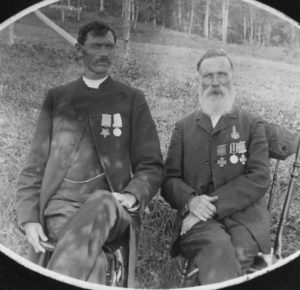Click on the “play” button to hear the diary episode read aloud, and click on the green tab 1 to learn more about a word or phrase.
Find Du Vernet on a map.
Saturday, July 16:
Up bright and early, I went down to the river and had a swim. Fortunately the wind was blowing the mosquitoes away from the bend of the barge. After dressing I lay on the barge to get a little rest.

After breakfast I took a look round the mission property. In two years, Mr. Johnston 2 has cleared about 5 acres, and has a garden which looks well. There is also a log stable and an icehouse 3 , but this has not preserved ice this year owing to the heavy rains. The house (wooden clap boarded, with an extension kitchen) stands on a pretty site back from the river a hundred yards. Then there is a little dip and beyond this on a second and higher hill is the Church 4 , the flag staff being placed between the two.
The Church is on the site of the old Chief’s 5 house. How this was managed shows some ingenuity on the part of Mr. Johnston: he went to the present Chief 6 (a son of the old Chief) and said “I do not know how you do things here but among white people in the far lands, it is very customary to erect a building as a monument to some great man. Now we are going to build a Church. If we were to build it on the site of your father’s old house which has tumbled to pieces, this would be a monument to him 7 . For years to come people passing up and down the river would say ‘that Church marks the site of where the old Chief of this Reserve used to live.’” Chief Blackbird 8 was very much taken with this idea and gave his consent to the Church being built there. The old Chief’s grave is near the bank of the River.

The Church is a very neat wooden building, clap boarded on the outside walls and the walls and ceiling are boarded inside. It is built in a cruciform 9 and has a chancel 10 . Mr. Johnston made the chancel rail and the reading desk. The inside is very bare and needs texts. A turret and a bell 11 are also needed. The bell would help bring many more to the services. At the back of the Church is the graveyard 12 , with two or three marble stones and a wooden cross. The Indians take great care of their graves 13 , and it is right that the Christians should do the same.
I took a photo of the Church from near the flag staff 14 and one of the graves as Mr. Johnston wanted to send a picture home to the relatives of a former Catechist from England 15 , to whose memory the white marble cross has been erected.